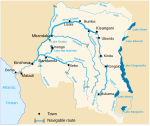Lomami River

The Lomami River (Swahili: Mto Lomami, French: Rivière Lomami, Dutch: Lomami Rivier) is a major tributary of the Congo River in the Democratic Republic of the Congo. The river is approximately 1,280 km (800 mi) long.[1] It flows north, west of and parallel to the upper Congo.
The Lomami rises in the south of the country, near Kamina and the Congo–Zambezi divide.[1] It flows north through Lubao, Tshofa, Kombe, Bolaiti, Opala, and Irema before joining the Congo at Isangi.
Henry Morton Stanley reached the confluence of the two rivers on 6 Jan. 1877, "the affluent Lumami, which Livingstone calls 'Young's river,' entered the great stream, by a mouth 600 yards wide, between low banks densely covered with trees."[2]: Vol.Two, 176
In October 1889 M. Janssen, Governor-General of the Congo State, explored the Lomani river upstream from Isangi on the Ville de Bruxelles. After steaming for 116 hours he was stopped by rapids at a latitude of 4°27'2" S.[3]
The river has lent its name to a number of biological species, including the monkey Cercopithecus lomamiensis and the flowering plant Pavetta lomamiensis.
References
[edit]- ^ a b Bossche, J.P. vanden; G. M. Bernacsek (1990). Source Book for the Inland Fishery Resources of Africa, Volume 1. Food and Agriculture Organization of the United Nations. p. 333. ISBN 978-92-5-102983-1.
- ^ Stanley, H.M., 1899, Through the Dark Continent, London: G. Newnes, Vol. One ISBN 0486256677, Vol. Two ISBN 0486256685
- ^ "The Lomami". Scottish Geographical Magazine. 6. Royal Scottish Geographical Society. 1890.
External links
[edit]
0°46′N 24°16′E / 0.767°N 24.267°E


 French
French Deutsch
Deutsch
